Are you someone who loves to challenge yourself with bizarre foods? Thai cuisine is renowned for its diversity and boldness, from crispy fried insects to unique fermented salads, ready to captivate even the pickiest foodies. Let’s dive into the top scary Thai dishes to see how many you’ve dared to try!
Why do scary dishes attract curious tourists?
The fascination with scary dishes among tourists is a captivating phenomenon in the culinary world. Here are some reasons why:
- Self-Challenge: Many see trying scary foods as a way to push their limits, explore new flavors, and prove their bravery.
- Cultural Curiosity: Scary dishes are often tied to a region’s unique culinary culture, sparking tourists’ interest in experiencing these distinctive traditions.
- Unique Experience: Eating unusual foods creates unforgettable memories and great stories to share with friends.
- Social Media Influence: Photos and videos of scary dishes shared widely on social media create a viral effect, piquing people’s curiosity.
- Thrill-Seeking: Some simply crave the excitement and novelty that comes with eating something out of the ordinary.
However, when trying these dishes, tourists should keep a few things in mind:
- Food Safety: Choose reputable places that prioritize hygiene to avoid health issues.
- Cultural Respect: Learn about the dish’s significance and proper way to enjoy it to avoid disrespectful behavior.
- Know Your Limits: If a dish feels too extreme, don’t force yourself to try it.
Top scary Thai dishes to try at least once in your life
Pla Ra – Thai fermented fish
Pla Ra (ปลาร้า) is a signature fermented fish paste in Thai cuisine, especially popular in Northeast Thailand (Isan) and Laos. Made from fresh fish (often freshwater species like carp or tilapia) fermented with salt and roasted rice or rice bran for months, Pla Ra has a pungent, intense flavor that can be off-putting to newcomers. The fermentation creates a distinctive tangy smell, sour taste, and unique fishy aroma, making it a memorable challenge.
Pla Ra is commonly used as a seasoning in dishes like som tam (papaya salad), soups, and dipping sauces, adding depth to the flavor. The intensity of its smell and taste varies depending on fermentation time—longer fermentation means a stronger aroma. While it may be overwhelming for some, locals and Thai food enthusiasts consider it essential for authentic traditional dishes.
Larb Mote Daeng – Dishes with red ants and their eggs
Red ant eggs are a familiar ingredient in Thailand, especially in Northeast dishes. Red ants lend a natural tangy flavor, adding freshness to the dish.
During the dry season, red ant eggs are highly valued in Thailand, sometimes costing up to 1,000 baht/kg, rivaling the price of salmon. For those who’ve tried it, this dish is irresistibly appealing. Red ant eggs are used in various dishes, from omelets and salads to curries and Tom Yum, offering a unique culinary experience.
Larb Mote Daeng (ลาบมดแดง) is a Thai specialty made from red ant eggs (mote daeng), a rare and unique ingredient. “Larb” is a traditional Thai spicy salad typically made with minced beef, pork, or chicken. Combined with red ant eggs, it becomes extraordinary, blending the creamy, nutty flavor of the eggs with fiery spices.
Larb Mote Daeng is mixed with herbs like green onions, cilantro, mint, chili, fish sauce, and lime juice. Popular in Northeast Thailand (Isan), locals make use of naturally abundant ant eggs. The eggs not only add a distinctive taste but are also a rich source of protein.
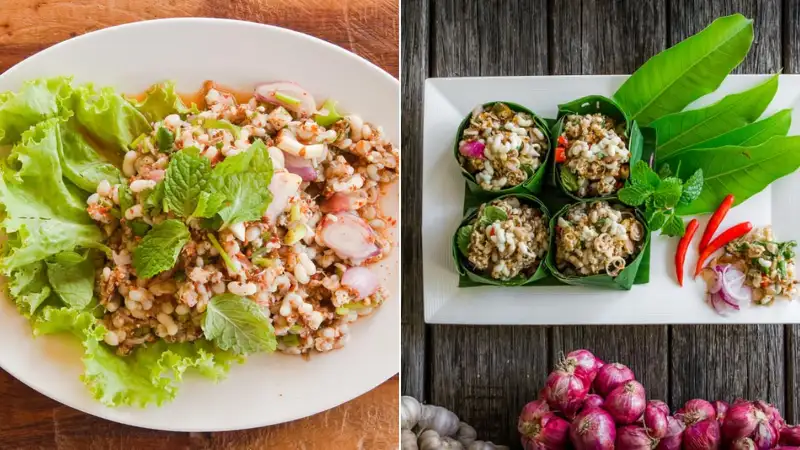
Goong Ten – Dancing live shrimp
Goong Ten (กุ้งเต้น), or “dancing shrimp,” is a unique and famous Thai street food. As the name suggests, it’s made from live, fresh shrimp—usually small ones—mixed with spices and herbs to create a vibrant raw salad.
Accompanying ingredients often include chili, green onions, cilantro, basil, and sweet-sour fish sauce, delivering Thailand’s signature spicy and tangy flavors. The fresh shrimp “dance” as they react to the seasoning, creating a fun and delicious experience. This dish impresses with its fresh ingredients and bold flavors, perfect for fans of daring street food.
Since the shrimp are alive, Goong Ten must be prepared and eaten immediately to ensure freshness and safety.
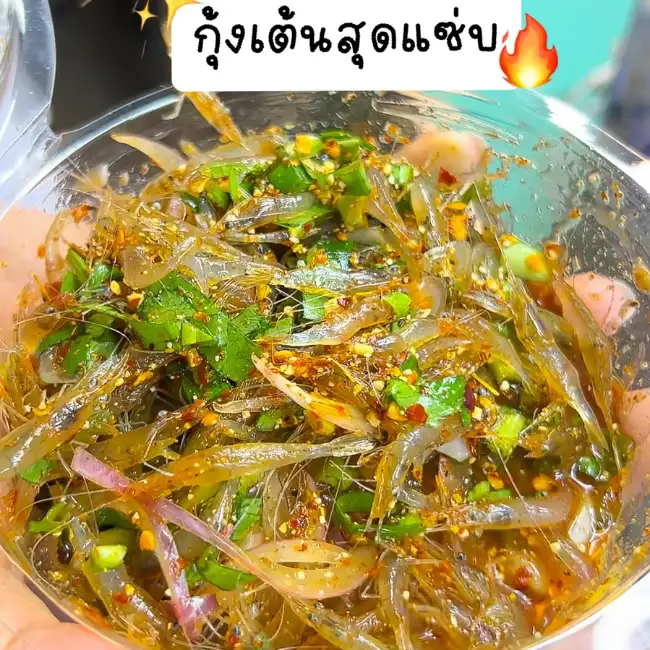
Khai Khem – Black salted duck eggs
Black salted duck eggs have a distinct black shell and firm yolk. Compared to regular salted eggs, Khai Khem has a sharp, pungent smell that can be intimidating. The eggs are intensely salty with a slight tanginess. To make them more palatable, they’re often paired with spices or used in soups and salads. Khai Khem is a polarizing dish—its unusual flavor is best suited for adventurous eaters.
In Thailand, salted eggs can be eaten with rice or used to enhance traditional dishes like Yam Khai Khem (salted egg salad) or Khao Pad Khai Khem (salted egg fried rice). Their bold flavor and unique texture make them a favorite among locals.
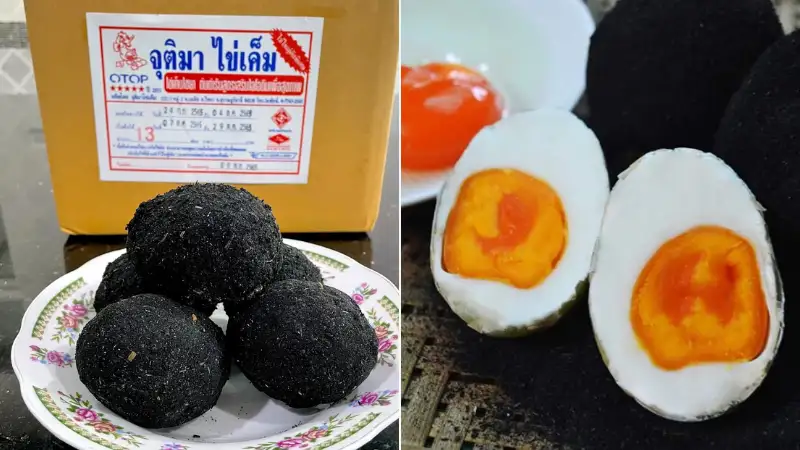
Larb Leuat Neua – Raw beef blood salad
Larb Leuat Neua is a distinctive Thai dish in the Larb family (spiced minced meat salad) but stands out for using fresh beef blood (leuat neua) as a key ingredient. This makes it a unique and somewhat shocking variation of traditional Larb.
The dish is prepared by mincing fresh beef and mixing it with beef blood, then tossing it with spices like lime, chili, garlic, basil, cilantro, and ground roasted rice. The result is a spicy, rich, and fresh dish, thanks to the blend of seasonings and blood.
Larb Leuat Neua is often served with rice or fresh vegetables and is popular in Northeast Thailand (Isan). It’s a favorite among those who enjoy bold, traditional flavors, though the use of fresh blood may surprise those unfamiliar with this preparation.
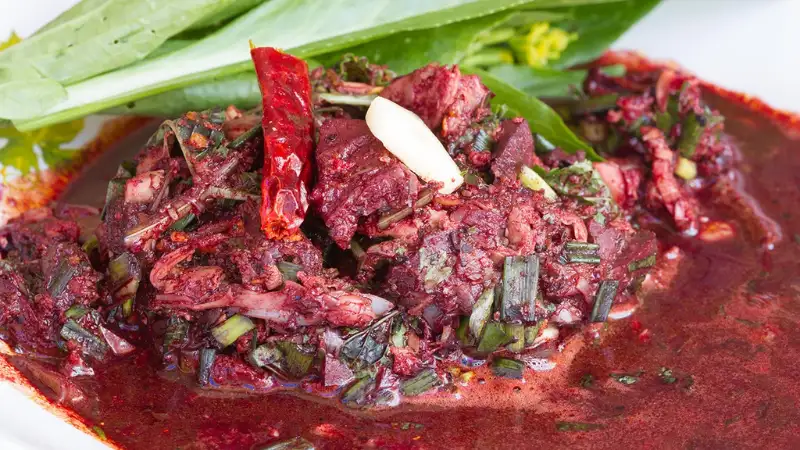
Jing Leed – Crispy fried crickets
Crickets are seasoned and fried to a crisp, making them a popular snack in Thailand. They have a nutty, crunchy texture that can be shocking for those not used to eating insects.
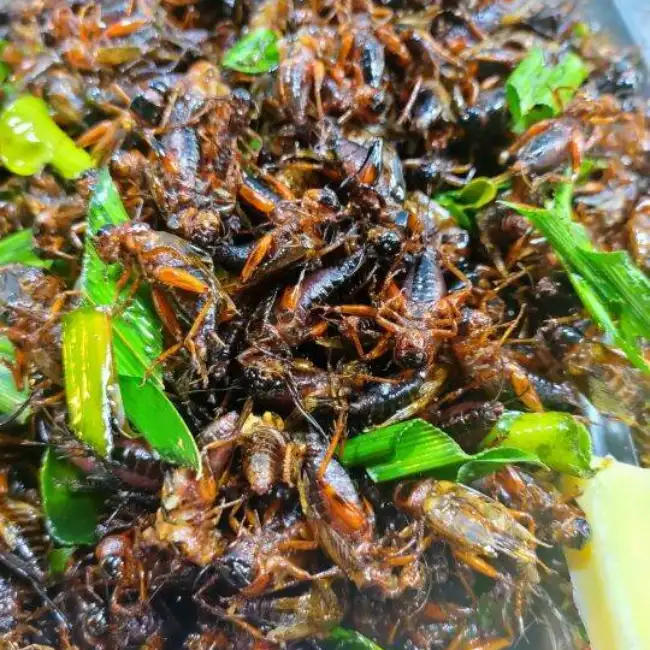
Dua Muen Dong – Fermented sour silkworm pupae
Dua Muen Dong is a fermented sour silkworm pupae dish, a unique specialty in Thai cuisine, particularly in the Northeast. After cleaning, the pupae are salted and fermented until they develop a distinct sour flavor. Fermentation enhances the taste and preserves the pupae.
The dish has a tangy, salty flavor and is often paired with chili, garlic, or herbs to boost its taste. For many, its strong smell and flavor can be challenging, but it’s a favorite among fans of fermented foods and high-protein dishes. Silkworm pupae are also nutritious, rich in protein and beneficial vitamins.
These daring Thai dishes promise unforgettable experiences. Thailand has plenty more unusual foods waiting to be explored. If you’re a thrill-seeker who loves new challenges, don’t hesitate to visit Thailand and try these unique dishes! Check out more exciting articles about Thailand in our Thailand News section!
